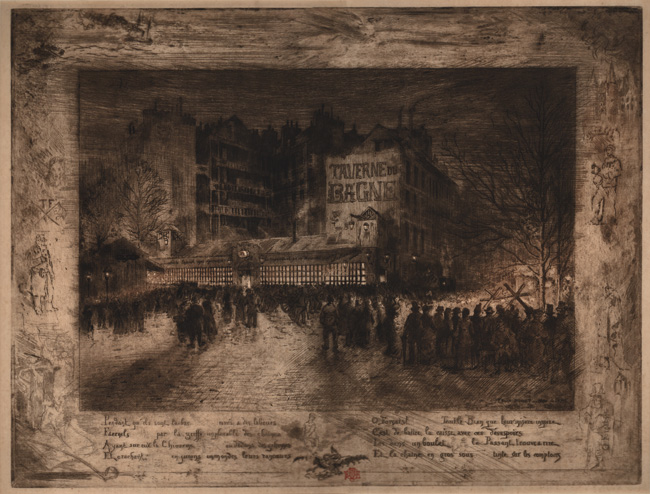Standards
- van Meckenem, Ecce Homo
- Dürer, Saint Jerome
- Dürer, The Little Courier
- Dürer, The Satyr Family
- Raimondi, Façade with Caryatids
- Altdorfer, The Resurrection
- Beham, Peasant Couple
- Beham or Dürer, Bookplate
- Pencz, The Life of Christ
- Davent, Musicians
- Lautensack, Landscape
- Matham, The Planets
- Callot, Balli di Sfessania
- Callot, La Chasse au Cerf
- Rembrandt, Clement de Jonghe
- Rembrandt, The Goldsmith
- Della Bella, The Five Deaths
- Ostade, The Fiddler
- Both, The Five Senses
- Nanteuil, Hardouin de Beaumont
- Visscher, A Mouse in a Mouse Trap
- Masson, Guilllaume de Brisacier
- Piranesi, A View of the Temple
- Watson, Mrs. Hale as Euphrosyne
- Moreau, Les Petits Parains
- Janinet, Le Sommeil d’Arianne
- Blake, And My Servant Job
- Unknown Engraver, Frederick
- Gericault, Horses Going to a Fair
- Jacque, Les Musiciens
- Haden, A By-Road in Tipperary
- Meryon, Saint-Etienne-du-Mont
- Bresdin, La Sainte Famille
- Whistler, Battersea Dawn
- Whistler, Limehouse
- Fantin-Latour, Manfred and Astarte
- Legros, Le Grand Canal
- Buhot, La Place des Martyrs
- Forain, Le Calvaire (2e planche)
- Pennell, In the Mist of the Morning
- Hassam, The Old Mulford House
- Zorn, "Oxenstierna"
- Toulouse-Lautrec, La Modiste
- Cameron, The Palace
- Sloan, Anshutz on Anatomy
- Bone, The Trevi Fountain, Rome
- Knight, At the Footlights
- McBey, Palestine: Blue Bonnets
La Place des Martyrs et la Taverne du Bagne
Etching, drypoint, aquatint, roulette and stop-out, 1885, B/G 163 iii/iii, 335 x 447 mm. Very fine and rich impression in brown-black ink on thin, laid japan paper with good margins, signed with the red owl stamp; a minor printer’s crease, a pale water stain in the lower margin and a small piece of the paper edge lacking. Buhot was probably the most experimental printmaker of his time, using every conceivable technique to achieve the effects he wanted. This print started out as a daytime scene and developed into the much more effective and famous night scene, with dots of light coming from windows and lamps and a lesser glow on the crowd and the facades. The Place des Martyrs was just down the street from Buhot’s residence on the Boulevard de Clichy and was a popular nighttime gathering place. The Tavern welcomed its clients by having them denounced, and sometime manacled, by men dressed as prison guards, and led inside to be waited on by others in jail garb and chains in a dark room decorated with bath scenes (the sound of the word bagne is close to that of bain or bath). It was a very fashionable cabaret and its owner was a former convict in a French penal colony. The print is decorated with verses evoking the ambiance of the place by Jean Le Fustec, a Breton bard, druid, Parisian journalist – and friend of Buhot.
![]()
